
The Macariini are a tribe of geometer moths in the subfamily Ennominae. Though they share many traits with the Sterrhinae, this is probably plesiomorphic rather than indicative of a close relationship, and DNA sequence data points to the Boarmiini as particularly close relatives of the Macariini. All things considered, this tribe might still resemble the first Ennominae more than any other living lineage in the subfamily.

The Bistonini are a tribe of geometer moths in subfamily Ennominae. As numerous ennomine genera have not yet been assigned to a tribe, the genus list is preliminary. In addition, the entire tribe is sometimes merged into a much-expanded Boarmiini. In other treatments, the Erannini are included in the present group.

The Ennomini are a tribe of geometer moths in the Ennominae subfamily. They are large-bodied and rather nondescript Ennominae, overall showing many similarities to the closely related Azelinini and Nacophorini.

The Ourapterygini are one of the large tribes of geometer moths in the subfamily Ennominae. The tribe was described by Charles Théophile Bruand d'Uzelle in 1846. They are particularly plentiful in the Neotropics. Ourapterygini are generally held to be the youngest tribe of their subfamily, and at least seasonally have characteristic apomorphic asymmetrical processes of the anellus.
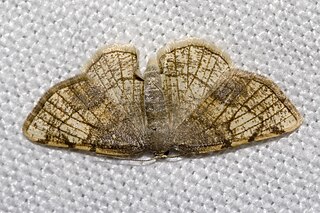
The Abraxini are a tribe of geometer moths in the subfamily Ennominae. Here, the Cassymini are considered a specialized offshoot of the Abraxini and merged therein; some authors consider them a distinct tribe however.

Nemoriini are tribes of geometer moths in the subfamily Geometrinae.

Larentiinae is a subfamily of moths containing roughly 5,800 species that occur mostly in the temperate regions of the world. They are generally considered a subfamily of the geometer moth family (Geometridae) and are divided into a few large or good-sized tribes, and numerous very small or even monotypic ones which might not always be valid. Well-known members are the "pug moths" of the Eupitheciini and the "carpets", mainly of the Cidariini and Xanthorhoini. The subfamily was described by Philogène Auguste Joseph Duponchel in 1845.

The Cidariini are the largest tribe of geometer moths in the subfamily Larentiinae. The Cidariini include many of the species known as "carpets" or, ambiguously, "carpet moths", and are among the few geometer moths that have been subject to fairly comprehensive cladistic study of their phylogeny. The tribe was described by Philogène Auguste Joseph Duponchel in 1845.
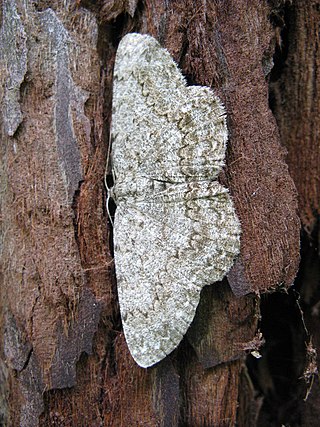
The Boarmiini are a large tribe of geometer moths in the Ennominae subfamily.

Though small in absolute diversity of genera, the Hemitheini are nonetheless the largest tribes of geometer moths in the subfamily Geometrinae. Like most Geometrinae, they are small greenish "emerald moths". The tribe was first described by Charles Théophile Bruand d'Uzelle in 1846.

Ectropis is a genus in the geometer moth family (Geometridae). They are mostly paleotropical, but also plentiful in Australia and extend into Asia. Only one species – or cryptic species complex – is found in Europe. There are about 100 known species in this genus.
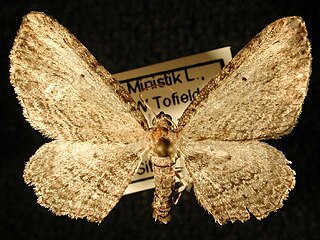
Horisme is a genus of moths in the family Geometridae. The genus was described by Jacob Hübner in 1825.
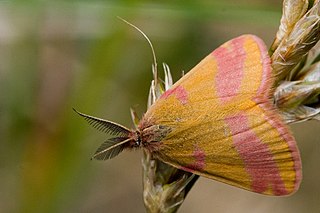
Lythria is a genus of moths in the family Geometridae erected by Jacob Hübner in 1823. It is the only genus of the monotypic tribe Lythriini described by Claude Herbulot in 1962.

Orthonama is a genus of the geometer moth family (Geometridae). It belongs to the tribe Xanthorhoini of the "carpet" subfamily (Larentiinae). Nycterosea is usually included here by modern authors, but may in fact be distinct enough to warrant recognition as an independent genus. The genus was erected by Jacob Hübner in 1825.

Xanthorhoini is a tribe of geometer moths under subfamily Larentiinae. The tribe was described by Pierce in 1914.

Cataclysmiini is a tribe of geometer moths in subfamily Larentiinae.
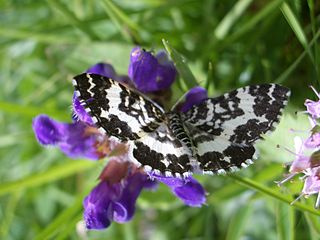
Rheumapterini is a tribe of geometer moths under subfamily Larentiinae.
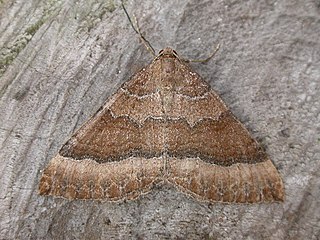
Larentiini is a tribe of geometer moths under subfamily Larentiinae. The tribe was first described by Philogène Auguste Joseph Duponchel in 1845.

Perizomini is a tribe of geometer moths under subfamily Larentiinae. It was first proposed by Claude Herbulot in 1961. It contains four genera, including the eponymous Perizoma.

Desmobathrinae is a subfamily of the moth family Geometridae described by Edward Meyrick in 1886.




















